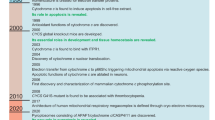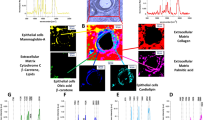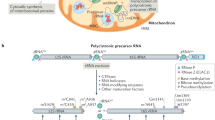Abstract
Leishmania major is a protozoan parasite from one of the most ancient phylogenic branches of unicellular eukaryotes, and containing only one giant mitochondrion. Here we report that staurosporine, that induces apoptosis in all mammalian nucleated cells, also induces in L. major a death process with several cytoplasmic and nuclear features of apoptosis, including cell shrinkage, phosphatidyl serine exposure, maintenance of plasma membrane integrity, mitochondrial transmembrane potential (ΔΨm) loss and cytochrome c release, nuclear chromatin condensation and fragmentation, and DNA degradation. Nuclear apoptosis-like features were prevented by cysteine proteinase inhibitors, and cell free assays using dying L. major cytoplasmic extracts indicated that the cysteine proteinases involved (i) also induced nuclear apoptosis-like features in isolated mammalian nuclei, and (ii) shared at least two nuclear substrates, but no cleavage site preference, with human effector caspases. Finally, isolated L. major mitochondria released cytochrome c and cysteine proteinases with nuclear pro-apoptotic activity when incubated with human recombinant Bax, even (although much less efficiently) when Bax was deleted of its transmembrane domain required for insertion in mitochondrial outermembranes, implying that L. major mitochondrion may express proteins able to interact with Bax. The recruitment of cysteine proteinases and mitochondria to the cell death machinery may be of very ancient evolutionary origin. Alternately, host/parasite interactions may have exerted selective pressures on the cell death phenotype of kinetoplastid parasites, resulting in the more recent emergence of an apoptotic machinery through a process of convergent evolution.
Similar content being viewed by others
Log in or create a free account to read this content
Gain free access to this article, as well as selected content from this journal and more on nature.com
or
Abbreviations
- BAF:
-
Boc-Asp(OMe)-CH2F
- E64:
-
trans-Epoxysuccinyl-L-Leucylamido-(4-Guanido)Butane
- AIF:
-
Apoptosis Inducing Factor
- CAD:
-
Caspase Activated Dnase
- ΔΨm:
-
mitochondrial transmembrane potential
- ICAD:
-
Inhibitor of Caspase Activated Dnase
- PARP:
-
Poly(ADP-ribose) polymerase
References
Jacobson MD, Weil M, Raff MC . 1997 Programmed cell death in animal development Cell 88: 347–354
Vaux DL, Korsmeyer J . 1999 Cell death in development Cell 96: 245–254
Meier P, Finch A, Evan G . 2000 Apoptosis in development Nature 407: 796–801
Hengartner M . 2000 The biochemistry of apoptosis Nature 407: 770–776
Horvitz HR . 1999 Genetic control of programmed cell death in the nematode Caenorhabditis elegans Cancer Res 59 Suppl: 11701–11706
Thornberry NA, Lazebnik Y . 1998 Caspases: enemies within Science 281: 1312–1316
Green DR . 2000 Apoptotic pathways: Paper wraps stone blunt scissors Cell 102: 1–4
Gross A, McDonnell JM, Korsmeyer SJ . 1999 Bcl-2 family members and the mitochondria in apoptosis Genes Dev. 13: 1899–1911
Martinou JC, Green D . 2001 Breaking the mitochondrial barrier Nature Reviews Mol. Cell. Biol. 2: 63–67
Zamzami N, Kroemer G . 2001 The mitochondrion in apoptosis: how Pandora's box opens Nature Rev. Mol. Cell. Biol. 2: 67–71
Xiang J, Chao DT, Korsmeyer SJ . 1996 Bax-induced cell death may not require ICE-like proteases Proc. Natl. Acad. Sci. USA 93: 14559–14563
Quignon F, De Bels F, Koken M, Feuteun J, Ameisen JC, de Thé H . 1998 PML induces a novel caspase-independent death process Nat. Genet. 20: 259–265
Vercammen D, Brouckaert G, Denecker G, Van de Craen M, Declercq W, Fiers W, Vandenabeele P . 1998 Dual signaling of the Fas receptor: initiation of both apoptotic and necrotic cell death pathways J. Exp. Med. 188: 919–930
Chautan M, Chazal G, Cecconi F, Gruss P, Golstein P . 1999 Interdigital cell death can occur through a necrotic and caspase-independent pathway Curr. Biol. 9: 967–970
Holler N, Zaru R, Micheau O, Thome M, Attinger A, Valitutti S, Bodmer JL, Schneider P, Seed B, Tschopp J . 2000 Fas triggers an alternative caspase 8-independent cell death pathway using kinase RIP as effector molecule Nat. Immunol. 1: 489–495
Sperandio S, deBelle I, Bredesen D . 2000 An alternative non apoptotic form of programmed cell death Proc. Natl. Acad. Sci. USA 97: 14376–14381
Ameisen JC . 1996 The origin of programmed cell death Science 272: 1278–1279
Umansky SR . 1982 The genetic program of cell death: hypothesis and some applications: transformation, carcinogenesis, ageing J. Theor. Biol. 97: 591–602
Raff MC . 1992 Social controls on cell survival and cell death Nature 356: 397–400
Evan GA . 1994 Old cells never die, they just apoptose Trends Cell. Biol. 4: 191–192
Vaux DL, Haeker G, Strasser A . 1994 An evolutionary perspective on apoptosis Cell. 76: 777–779
Steller H . 1995 Mechanisms and genes of cellular suicide Science 267: 1445–1449
Ameisen JC . 1998 The evolutionary origin and role of programmed cell death in single celled organisms: a new view of executioners, mitochondria, host-pathogen interactions, and the role of death in the process of natural selection In When cells die R Lockshin, Z Zakeri and J Tilly, (eds) New York: Wiley-Liss, Inc. pp 3–56
Cornillon S, Foa C, Davoust J, Buonavista N, Gross JD, Golstein P . 1994 Programmed cell death in Dictyostelium J. Cell Sci. 107: 2691–2704
Ameisen JC, Idziorek T, Billaut-Mulot O, Loyens M, Tissier JP, Potentier A, Ouaissi MA . 1995 Apoptosis in a unicellular eukaryote (Trypanosoma cruzi): implications for the evolutionary origin and role of programmed cell death in the control of cell proliferation, differentiation and survival Cell Death Differ. 2: 285–300
Welburn SC, Dale C, Ellis D, Beecroft R, Pearson TW . 1996 Apoptosis in procyclic Trypanosoma brucei rhodesiense in vitro Cell Death Differ. 3: 229–236
Moreira MEC, DelPortillo HA, Milder RV, Balanco JM, Barcinski MA . 1996 Heat shok induction of apoptosis in promastigotes of the unicellular organism Leishmania amazonensis J. Cell. Physiol. 167: 305–313
Christensen ST, Wheatley DN, Rasmussen MI, Rasmussen L . 1995 Mechanisms controlling death, survival and proliferation in a model unicellular eukaryote Tetrahymena thermophila Cell Death Differ. 2: 301–308
Vardi A, Berman-Frank I, Rozenberg T, Hadas O, Kaplan A, Levine A . 1999 Programmed cell death of the dinoglagellate Peridinium gatunense is mediated by CO2 limitation and oxidative stress Curr. Biol. 9: 1061–1064
Olie RA, Durrieu F, Cornillon S, Loughran G, Gross J, Earnshow WC, Golstein P . 1998 Apparent caspase independence of programmed cell death in Dictyostelium Curr. Biol. 8: 955–958
Sogin ML . 1991 Early evolution and the origin of eukaryotes Curr. Opin. Genet. Dev. 1: 457–463
Doolittle RF, Feng DF, Tsang S, Cho G, Little E . 1996 Determining divergence times of the major kingdoms of living organisms with a protein clock Science 271: 470–477
Nagata S . 2000 Apoptotic DNA fragmentation Exp. Cell. Res. 256: 12–18
Savill J, Fadok V . 2000 Corpse clearance defines the meaning of cell death Nature 407: 784–788
Weil M, Jacobson MD, Coles HSR, Davies TJ, Gardner RL, Raff KD, Raff MC . 1996 Constitutive expression of the machinery for programmed cell death J. Cell. Biol. 133: 1053
Kerr JFR, Willie AH, Currie AR . 1972 Apoptosis: a basic biological phenomenon with wide-ranging implications in tissue kinetics Br. J. Cancer 26: 239–257
Wang KKW . 2000 Calpain and caspases: can you tell the difference? Trends Neurosci. 23: 20
Martin SJ, Newmeyer DD, Mathias S, Farschon DM, Wang HG, Reed JC, Kolesnick RN, Green DR . 1995 Cell-free reconstitution of Fas-, UV radiation- and ceramide-induced apoptosis EMBO J. 14: 5191–5200
Lazebnik YA, Kaufmann SH, Desnoyers S, Poirier GG, Earnshaw WC . 1994 Cleavage of poly(ADP-ribose) polymerase by a proteinase with properties like ICE Nature 371: 346–347
Lechardeur D, Drzymala L, Sharma M, Zylka DK, Pacia J, Hicks C, Usmani N, Rommens JM, Lukacs GL . 2000 Determinants of the nuclear localization of the heterodimeric DNA fragmentation factor (ICAD/CAD) J. Cell. Biol. 150: 321–334
Sakahira H, Enari M, Nagata S . 1999 Functional differences of two forms of the inhibitor of caspase- activated DNase, ICAD-L, and ICAD-S J. Biol. Chem. 274: 15740–15744
Kluck RM, Ellerby LM, Ellerby HM, Naiem S, Yaffe MP, Margoliash E, Bredesen D, Mauk AG, Sherman F, Newmeyer D . 2000 Determinants of cytochrome c pro-apoptotic activity. The role of lysine 72 trimethylation J. Biol. Chem. 275: 16127–16133
Lorenzo H, Susin S, Penninger J, Kroemer G . 1999 Apoptosis inducing factor (AIF): a phylogenetically old, caspase-independent effector of cell death Cell Death Differ. 6: 516–524
Arnoult D, Tatischeff I, Estaquier J, Girard M, Sureau F, Tissier JP, Grodet A, Dellinger M, Traincard F, Kahn A, Ameisen JC, Petit PX . 2001 On the evolutionary conservation of the cell death pathway: mitochondrial release of an Apoptosis Inducing Factor during Dictyostelium discoideum cell death Mol. Biol. Cell 12: in press
Shimizu S, Shinohara Y, Tsujimoto Y . 2000 Bax and Bcl-xL independently regulate apoptotic changes of yeast mitochondria that require VDAC but not adenine nucleotide translocator Oncogene 19: 4309–4318
Roucou X, Prescott M, Devenish RJ, Nagley P . 2000 A cytochrome c-GFP fusion is not released from mitochondria into the cytoplasm upon expression of Bax in yeast cells FEBS Lett. 471: 235–239
Gross A, Pilcher K, Blachly-Dyson E, Basso E, Jockel J, Bassik MC, Korsmeyer SJ, Forte M . 2000 Biochemical and genetic analysis of the mitochondrial response of yeast to Bax and Bcl-xL(L) Mol. Cell. Biol. 20: 3125–3136
Eskes R, Antonsson B, Osen-Sand A, Montessuit S, Richter C, Sadoul R, Mazzei G, Nichols A, Martinou JC . 1998 Bax-induced cytochrome C release from mitochondria is independent of the permeability transition pore but highly dependent on Mg2+ ions J. Cell. Biol. 143: 217–224
Aravind L, Dixit VM, Koonin EV . 2001 Apoptotic molecular machinery: vastly increased complexity in vertebrates revealed by genome comparisons Science 291: 1279–1284
Wolf BB, Golstein JC, Stennicke HR, Beere H, Amarante-Mendes GP, Salvesen GS, Green DR . 1999 Calpain functions in a caspase-independent manner to promote apoptotic-like events during platelet activation Blood. 94: 1683
Frame MJ, Mottram JC, Coombs GH . 2000 Analysis of the roles of cysteine proteinases of Leishmania mexicana in the host-parasite interaction Parasitology. 121: 367–377
Selzer PM, Pingel S, Hsieh I, Ugele B, Chan VJ, Engel JC, Bogyo M, Russell DG, Sakanari JA, McKerrow JH . 1999 Cysteine protease inhibitors as chemotherapy: lessons from a parasite target Proc. Natl. Acad. Sci. USA. 96: 11015–11022
Wei MC, Zong WX, Cheng EH, Lindsten T, Panoutsakopoulou V, Ross AJ, Roth KA, MacGregor GR, Thompson CB, Korsmeyer SJ . 2001 Proapoptotic BAX and BAK: a requisite gateway to mitochondrial dysfunction and death Science 292: 727–730
Green DR, Beere HM . 2000 Apoptosis: Gone but not forgotten Nature 405: 28–29
Freire-de-Lima CG, Nascimento DO, Soares MBP, Bozza PT, Castro-Faria-Neto HC, de Mello FG, DosReis GA, Lopes MF . 2000 Uptake of apoptotic cells drives the growth of a pathogenic trypanosome in macrophages Nature 403: 199–203
Harris ME, Moore DR, Hajduk SL . 1990 Addition of uridines to edited RNAs in trypanosome mitochondria occurs independently of transcription J. Biol. Chem. 265: 11368–11376
Antonsson B, Conti F, Ciavatta A, Montessuit S, Lewis S, Martinou I, Bernasconi L, Bernard A, Mermod JJ, Mazzei G, Maundrell K, Gambale F, Sadoul R, Martinou JC . 1997 Inhibition of Bax channel-forming activity by Bcl-2 Science 277: 370–372
Acknowledgements
We are very grateful to B Antonsson (Serono Pharmaceutical research Institute, Serono International, SA, Geneva, Switzerland) and JC Martinou (Departement de Biologie Cellulaire, Universite de Geneva, Geneva, Switzerland) for providing the recombinant full length and ΔTM Bax and for helpful discussions; to R Kluck (La Jolla Institute for Allergy and Immunology, San Diego, CA, USA) for providing an anti-yeast cytochrome c antibody; to. YJ-F Garin (Hopital Saint Louis, France) for providing L. major; and to G Kroemer and S Susin (Villejuif, France) for providing an anti-mammalian AIF antibody. EMI-U 9922 is supported by Institut National de la Sante et de la Recherche Medicale (INSERM) and Universite Paris 7, and by grants from Agence Nationale de Recherches sur le Sida (ANRS), Ensemble contre le Sida (ECS), Fondation pour la Recherche Medicale (FRM), Etablissement Francais des Greffes (to JC Ameisen). D Arnoult was supported by doctoral fellowships from Delegation Generale de l'Armement (DGA) and FRM and K Akarid by a post-doctoral fellowship from ECS.
Author information
Authors and Affiliations
Corresponding author
Additional information
Edited by G Melino
Rights and permissions
About this article
Cite this article
Arnoult, D., Akarid, K., Grodet, A. et al. On the evolution of programmed cell death: apoptosis of the unicellular eukaryote Leishmania major involves cysteine proteinase activation and mitochondrion permeabilization. Cell Death Differ 9, 65–81 (2002). https://doi.org/10.1038/sj.cdd.4400951
Received:
Revised:
Accepted:
Published:
Issue date:
DOI: https://doi.org/10.1038/sj.cdd.4400951
Keywords
This article is cited by
-
Cell death of Acanthamoeba castellanii following exposure to antimicrobial agents commonly included in contact lens disinfecting solutions
Parasitology Research (2024)
-
Arab world’s growing contribution to global leishmaniasis research (1998–2017): a bibliometric study
BMC Public Health (2019)
-
Moroccan strains of Leishmania major and Leishmania tropica differentially impact on nitric oxide production by macrophages
Parasites & Vectors (2017)
-
Zinc depletion promotes apoptosis-like death in drug-sensitive and antimony-resistance Leishmania donovani
Scientific Reports (2017)
-
Evolution of caspase-mediated cell death and differentiation: twins separated at birth
Cell Death & Differentiation (2017)



